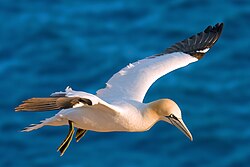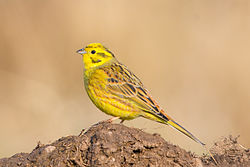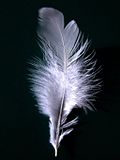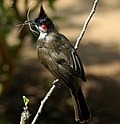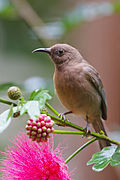Portal:Birds
The Birds Portal

Birds are a group of warm-blooded vertebrates constituting the class Aves (Latin: [ˈaːwεs]), characterised by feathers, toothless beaked jaws, the laying of hard-shelled eggs, a high metabolic rate, a four-chambered heart, and a strong yet lightweight skeleton. Birds live worldwide and range in size from the 5.5 cm (2.2 in) bee hummingbird to the 2.8 m (9 ft 2 in) common ostrich. There are over 11,000 living species and they are split into 44 orders. More than half are passerine or "perching" birds. Birds have wings whose development varies according to species; the only known groups without wings are the extinct moa and elephant birds. Wings, which are modified forelimbs, gave birds the ability to fly, although further evolution has led to the loss of flight in some birds, including ratites, penguins, and diverse endemic island species. The digestive and respiratory systems of birds are also uniquely adapted for flight. Some bird species of aquatic environments, particularly seabirds and some waterbirds, have further evolved for swimming. The study of birds is called ornithology.
Birds are feathered theropod dinosaurs and constitute the only known living dinosaurs. Likewise, birds are considered reptiles in the modern cladistic sense of the term, and their closest living relatives are the crocodilians. Birds are descendants of the primitive avialans (whose members include Archaeopteryx) which first appeared during the Late Jurassic. According to some estimates, modern birds (Neornithes) evolved in the Late Cretaceous or between the Early and Late Cretaceous (100 Ma) and diversified dramatically around the time of the Cretaceous–Paleogene extinction event 66 million years ago, which killed off the pterosaurs and all non-ornithuran dinosaurs.
Many social species preserve knowledge across generations (culture). Birds are social, communicating with visual signals, calls, and songs, and participating in such behaviour as cooperative breeding and hunting, flocking, and mobbing of predators. The vast majority of bird species are socially (but not necessarily sexually) monogamous, usually for one breeding season at a time, sometimes for years, and rarely for life. Other species have breeding systems that are polygynous (one male with many females) or, rarely, polyandrous (one female with many males). Birds produce offspring by laying eggs which are fertilised through sexual reproduction. They are usually laid in a nest and incubated by the parents. Most birds have an extended period of parental care after hatching.
Many species of birds are economically important as food for human consumption and raw material in manufacturing, with domesticated and undomesticated birds being important sources of eggs, meat, and feathers. Songbirds, parrots, and other species are popular as pets. Guano (bird excrement) is harvested for use as a fertiliser. Birds figure throughout human culture. About 120 to 130 species have become extinct due to human activity since the 17th century, and hundreds more before then. Human activity threatens about 1,200 bird species with extinction, though efforts are underway to protect them. Recreational birdwatching is an important part of the ecotourism industry. (Full article...)
Featured articles
Selected general bird topic

The wingspan (or just span) of a bird or an airplane is the distance from one wingtip to the opposite wingtip. For example, the Boeing 777–200 has a wingspan of 60.93 metres (199 ft 11 in), and a wandering albatross (Diomedea exulans) caught in 1965 had a wingspan of 3.63 metres (11 ft 11 in), the official record for a living bird. The term wingspan, more technically extent, is also used for other winged animals such as pterosaurs, bats, insects, etc., and other aircraft such as ornithopters. In humans, the term wingspan also refers to the arm span, which is the distance between the length from the end of an individual's arm (measured at the fingertips) to the individual's fingertips on the other arm when raised parallel to the ground at shoulder height. (Full article...)
Selected taxon
The indigobirds, whydahs and cuckoo-finch make up the family Viduidae; they are small passerine birds native to Africa.
These are finch-like species which usually have black or indigo predominating in their plumage. The birds named "whydahs" have long or very long tails in the breeding male.
All are obligate brood parasites, which lay their eggs in the nests of songbird species; most indigobirds use firefinches as hosts, whereas the paradise whydahs choose pytilias and the cuckoo-finch parasitises cisticolids. Unlike the cuckoos and honeyguides, the indigobirds and whydahs do not destroy the host's eggs. Typically, they lay 2–4 eggs in with those already present. The eggs of both the host and the victim are white, although the indigobird's are slightly larger. Many of the indigo-plumaged species named "indigobirds" are very similar in appearance, with the males difficult to separate in the field, and the young and females near impossible. The best guide is often the estrildid finch with which they are associating, since each indigobird parasitises a different host species. For example, the village indigobird is usually found with red-billed firefinches. Indigobirds and whydahs imitate their host's song, which the males learn in the nest. Although females do not sing, they also learn to recognise the song, and choose males with the same song, thus perpetuating the link between each species of indigobird and firefinch. The nestling indigobirds mimic the unique gape pattern of the fledglings of the host species. (Full article...)
Topics
Anatomy: Anatomy • Skeleton • Flight • Eggs • Feathers • Plumage
Evolution and extinction: Evolution • Archaeopteryx • Hybridisation • Late Quaternary prehistoric birds • Fossils • Taxonomy • Extinction
Behaviour: Singing • Intelligence • Migration • Reproduction • Nesting • Incubation • Brood parasites
Bird orders: Struthioniformes • Tinamiformes • Anseriformes • Accipitriformes • Galliformes • Gaviiformes • Podicipediformes • Procellariiformes • Sphenisciformes • Pelecaniformes • Ciconiiformes • Phoenicopteriformes • Falconiformes • Gruiformes • Charadriiformes • Pteroclidiformes • Columbiformes • Psittaciformes • Cuculiformes • Strigiformes • Caprimulgiformes • Apodiformes • Coraciiformes • Piciformes • Trogoniformes • Coliiformes • Passeriformes
Bird lists: Families and orders • Lists by region
Birds and humans: Ringing • Ornithology • Bird collections • Birdwatching • Birdfeeding • Conservation • Aviculture
Quotes
| “ | Does wisdom perhaps appear on the earth as a raven which is inspired by the smell of carrion? | ” |
Resources
Free online resources:
- SORA: The Searchable Online Research Archive (SORA) has decades worth of archives of the following journals: The Auk, The Condor, Journal of Field Ornithology, North American Bird Bander, Studies in Avian Biology, Pacific Coast Avifauna, and The Wilson Bulletin. Coverage ends around 2000. The ability to search all journals or browse exists on the front page.
- Notornis: The Journal of the Ornithological Society of New Zealand covers New Zealand and the South Pacific.
- New Zealand Journal of Ecology: This journal often publishes bird-related articles. Like Notornis, this journal is concerned with New Zealand and surrounding areas.
- Marine Ornithology: Published by the numerous seabird research groups, Marine Ornithology is specific and goes back many years.
- BirdLife International: The Data Zone has species accounts for every species, although threatened species and some key groups have greater detail with others only having status and evaluation.
- Author Index: This is a good source for binomial authorities for taxoboxes.
There is also Birds of North America, Cornell University's massive project collecting information on every breeding bird in the ABA area. It is available for US$40 a year.
For more sources, including printed sources, see WikiProject Birds.
WikiProjects
Selected images
Selected bird anatomy topic

Wing chord is an anatomical measurement of a bird's wing. The measurement is taken with the wing bent at a 90-degree angle, from the most prominent point of the wrist joint to the most prominent point of the longest primary feather. It is often taken as a standard measurement of the proportions of a bird and used to differentiate between species and subspecies. (Full article...)
Selected species
Did you know
- ...that the hood mockingbird will occasionally attack people in an attempt to get fresh water from them?
- ...that prior to the development of binoculars, bird collections, collections consisting of birds and parts of their anatomy, were the dominant method of bird observation and study among ornithologists?
- ...that bird nests range in size from the tiny one inch high cup of some hummingbirds to the massive five meter high mounds of some dusky scrubfowl?
Categories
Related portals
Things you can do
Create requested articles (WikiProject Birds – Article requests):
Do these tasks:
 |
Here are some tasks awaiting attention:
|
More outstanding tasks at the project's cleanup listing, Category:Birds articles needing attention, and Wikipedia:WikiProject Birds/Todo.
Taxonomy of Aves
| Class Aves, divided into superorders, orders, suborders (where indicated), and families. | ||||
|---|---|---|---|---|
|
Associated Wikimedia
The following Wikimedia Foundation sister projects provide more on this subject:
-
Commons
Free media repository -
Wikibooks
Free textbooks and manuals -
Wikidata
Free knowledge base -
Wikinews
Free-content news -
Wikiquote
Collection of quotations -
Wikisource
Free-content library -
Wikispecies
Directory of species -
Wikiversity
Free learning tools -
Wikivoyage
Free travel guide -
Wiktionary
Dictionary and thesaurus
Sources
- ^ Commons, T.K. (2012). Instant Genius: Smart Mouths: The Best Quotations Ever Collected. Portable Press. p. pt56. ISBN 978-1-60710-684-5. Retrieved February 7, 2020.














